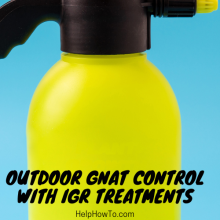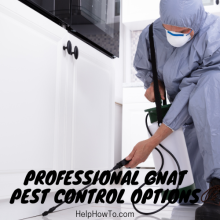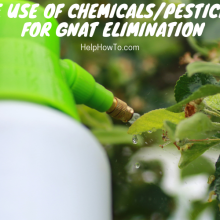Most Effective Indoor Gnat Foggers/Bug Bombs | HelpHowTo
Summary of Most Effective Indoor Gnat Foggers/Bug Bombs
Gnat infestations indoors can be extremely irritating and challenging to eliminate with traditional pest control methods. Gnat foggers and total release “bug bombs” provide a heavy-hitting solution by saturating interior spaces with insecticidal mists or vapors. Effective formulas utilize pyrethroids or botanical pyrethrins for rapid knockdown and residual protection.
While potent, foggers have limitations like strong odors, safety precautions required, and only killing adult gnats. An integrated pest management approach is critical – combining fogging with eliminating moisture sources that breed gnat larvae. Alternative natural, lower-toxicity fogger options are available for homes with children or pets. With proper application and preventative measures like drying moisture sites, even severe indoor gnat problems can be permanently solved using the dramatic knockdown power of foggers alongside environmental controls.

Our Top 5 Recommended Indoor Genat Traps
Sick of pesky gnats invading your home? Discover the top 5 indoor gnat traps to banish these annoying insects for good! Our expert reviews reveal the most effective, easy-to-use traps. From powerful UV attractants to eco-friendly vinegar traps, we’ve thoroughly tested and ranked the best solutions. Check Now

Eliminating Indoor Gnats: The Power of Foggers and Bug Bombs
Few pests are as irritating as gnats swarming around inside your home or office. Their small size allows these flying insects to enter through the tiniest cracks and holes. Once indoors, gnats quickly reproduce, laying eggs in moist organic materials like overwatered potting soil or kitchen drains. Before you know it, you have an all-out gnat infestation on your hands.
While gnats are more of a nuisance than a danger, constant buzzing and their presence around food areas is extremely unpleasant. Traditional pest control sprays often prove ineffective against a severe gnat problem. That’s where indoor gnat foggers and total release bug bombs come into play as a heavy-hitting solution.
Versatile and Potent Gnat Foggers
On the market today are gnat foggers designed specifically to eliminate fungus gnats, fruit flies, and other small fly species that commonly infest indoors. Examples include Bayer Gnat Fog, PT Cryonite, and Misty Insecticide. Many broader insect foggers like Hot Shot, Raid, and Pic also list gnat control on their product labels.
The most effective gnat foggers utilize synthetic pyrethroids like cyfluthrin or botanical pyrethrins as the active ingredients. These nerve agent insecticides provide rapid knockdown as well as long residual effects. Industrial and professional-grade formulas tend to pack a more powerful punch compared to household foggers.
Gnat foggers come in a few different delivery methods. Aerosol canisters release an ultra fine widespread insecticide mist when activated. Thermal foggers use heat to disperse concentrated insecticide liquid as a penetrating vapor. There are also simple handheld misters and space spray applicators.
Advantages of Bug Bombs for Gnat Control
For severe, whole-home gnat infestations, total release foggers or “bug bombs” are a nuclear option. These powerful units are set to automatically saturate an entire interior space with insecticide fog or smoke.
Top bug bomb brands for gnats include Kenco’s Vaportreat 23, PT Phantom, and Catchmatic. The fogging action allows insecticide to reach gnats hiding in cracks, crevices, under appliances, and inside walls. Bug bombs can even penetrate inside home hvac systems to target breeding sites.
Using Foggers Safely and Effectively
While extremely potent, gnat foggers and bug bombs do have downsides. Most insecticide products have strong odors that can be overwhelming. Proper preparation is required such as covering all food and surfaces, evacuating people and pets, and sealing off vents and fans.
Reentry periods of 2-6 hours or more may be needed after fogging to allow dissipation and settling of residues. Wiping down surfaces and running fans for ventilation is recommended upon reentry. Personal protective equipment like respirators should be worn during application as the fog can be an irritant.
The other main limitation of foggers is they only kill adult gnats. Any eggs and larvae remain unaffected to continue the breeding cycle. That’s why foggers alone cannot fully eliminate a gnat infestation without combining other preventative measures.
An Integrated Pest Management Approach
For complete indoor gnat control, fogging should be part of an integrated pest management program rather than a standalone solution. Identifying and eliminating sources of excess moisture that allow gnat larvae to develop is critical.
Common gnat breeding sites include overly wet potting soil, clogged drains, condensation around pipes and windows, and buildup in hvac pans or drains. Drying out these areas by increasing ventilation, repairing leaks, and removing buildup cuts off the food source for larvae.
Sticky traps and biological controls like beneficial nematodes can further reduce gnat populations by targeting the larvae life stage. Growth regulators stop the reproductive cycle. Landscaping practices that promote good drainage also deter outdoor gnats from moving indoors.
For severe, widespread infestations, bug bombing may need to be repeated every 7-14 days until gnat levels drop to acceptable thresholds. Foggers allow you to maintain control by spot treating any continued hot spots.
Natural and Pet-Safe Fogging Options
A key concern with conventional gnat foggers is the toxicity and potential hazards of synthetic insecticides, especially for homes with children or pets. Fortunately, there are some lower-impact botanical and natural options available.
Brands like EcoRaider, Grenade, and Wondercide offer a variety of organic insecticides and fogging products derived from chrysanthemum flowers, essential oils, and natural pyrethrins. While less potent than synthetic insecticides, these botanical foggers can still effectively kill gnats on contact with reapplication as needed.
Complete Indoor Gnat Elimination
Foggers and bug bombs provide dramatic knockdown capabilities to rapidly clear out severe indoor gnat infestations. However, these powerful tools are just one piece of an integrated approach for complete gnat control and prevention.
Combining fogging applications with identifying and eliminating moisture sources that breed gnats is critical. Removing the root causes deprives gnats of the ability to replenish their populations after fogging. Adopting good practices like drying out drains, fixing leaks, proper potting soil care, and landscaping creates an inhospitable environment.
With that multi-faceted offensive utilizing fogging along with prevention techniques, even the most overwhelming indoor gnat problems can be permanently solved. Just be sure to precisely follow product instructions and take proper safety precautions when deploying these heavy-hitting insecticide treatments.

Our Top 5 Recommended Indoor Genat Traps
Sick of pesky gnats invading your home? Discover the top 5 indoor gnat traps to banish these annoying insects for good! Our expert reviews reveal the most effective, easy-to-use traps. From powerful UV attractants to eco-friendly vinegar traps, we’ve thoroughly tested and ranked the best solutions. Check Now
FAQs and Answers
How long does the residual effect of gnat foggers last?
The residual effect or lasting protection provided by gnat foggers can vary depending on the specific product and formulation, but typically ranges from a few days up to a few weeks.
Aerosol foggers tend to have a shorter residual of 5-10 days on average. The insecticide dissipates more quickly after the initial knockdown.
Thermal foggers and total release “bug bombs” often leave more insecticide residues that can continue killing gnats for 2-4 weeks in some cases.
Professional/industrial strength gnat foggers formulated with synthetic pyrethroids like cy-fluthrin or bifenthrin frequently advertise 30-90 day residual protection.
However, the residual period can be impacted by factors like:
- Surfaces treated (porous vs non-porous)
- Air circulation and ventilation levels
- Exposure to sunlight/UV rays
- Cleaning/disturbance of treated areas
For ongoing prevention, most manufacturer guidelines recommend re-applying gnat foggers every 7-14 days initially until infestation is controlled, then monthly as a maintenance treatment. Using residual repellents like pyriproxyfen can also extend protection between fogger applications.
Are gnat foggers safe to use around houseplants, furniture, and other belongings?
Most gnat foggers are designed to be used indoors, but there are some important safety precautions to take regarding houseplants, furniture, and other belongings:
Houseplants
- Foggers can potentially damage or kill sensitive houseplants, especially when used at full strength
- Remove or cover plants during fogging treatment if possible
- Check product labels, as some foggers may be labeled as plant-safe when used as directed
Furniture/Upholstery
- Fogger insecticide residues can sometimes stain or damage certain materials
- Remove or cover furniture, especially anything made of silk, leather, or untreated wood
- Wipe down surfaces after treatment and allow proper ventilation before re-use
Electronics/Appliances
- Avoid fogging directly onto TVs, computers, and other electronics
- Unplug and cover appliances if possible to prevent insecticide buildup
Art/Collections
- Remove irreplaceable artwork, books, photos, etc. or cover thoroughly
- Fogger residue can potentially damage collectibles
In general, it’s best to remove or cover any valuable belongings before fogging. Clear non-porous surfaces after and ventilate fully. Follow all product precautions. Using lower concentration formulas around belongings can also reduce risk.
For heavy-duty foggers, removing items completely and treating the empty room is advisable if possible. With proper precautions, most foggers can be used safely around common household items.
Which is more effective for gnats – aerosol foggers or thermal foggers?
When it comes to effectively eliminating indoor gnat infestations, thermal foggers tend to be more potent and longer-lasting compared to aerosol foggers.
Thermal Fogger Advantages:
- Use heat to disperse insecticide particles in a dense penetrating vapor
- Vapor can reach gnats hiding in cracks, crevices, behind walls, in ductwork, etc.
- Leave heavier residual insecticide coating on surfaces
- Residue continues killing gnats that re-emerge over weeks
- Cover larger square footage with a single application
Aerosol Fogger Advantages:
- More compact and portable
- Easier to use for spot treatments or smaller areas
- Don’t require heating elements or setup
- Typically cheaper for casual/homeowner use
While aerosol foggers can initially knock down exposed adult gnats, their effects are not as long-lasting or widespread as thermal foggers. The ultra-fine mist dissipates more quickly.
Thermal fog saturates all areas more thoroughly. The higher concentration and residual insecticide coating prevents re-infestation by killing gnats continuing to hatch from larvae over time.
For severe gnat problems, pest control professionals often recommend starting with a thermal fogging treatment. Then aerosol foggers can be used for follow-up applications to maintain control of any lingering hot spots.
However, aerosol formulations may be sufficient for lighter, localized gnat issues when properly applied. But thermal foggers provide the biggest punch to eliminate sources and heavy infestations.
How do I determine the right size/amount of fogger products for different room or home sizes?
Determining the proper size and amount of fogger products for different room or home sizes is important to ensure adequate coverage and effectiveness against gnats. Here are some tips:
Aerosol Foggers:
- Check the product label for the square footage coverage
- Common ranges are 5-8 oz cans treating 5,000-6,000 cubic feet
- For larger rooms, use multiple cans as directed
- Factor in good air circulation to disperse the fog
Thermal Foggers:
- Consider the fogging rate in ounces or milliliters per minute
- Higher rates of 2-4 oz/min cover up to 20,000 cubic feet
- Lower rates of 1 oz/min or less for smaller areas 5,000-10,000 cubic feet
- Factor in run time needed based on square footage
Total Release “Bug Bombs”:
- Single units range from covering 5,000-25,000 cubic feet
- Use multiple bombs for larger homes over 20,000 cubic feet
- Utilize bombs on each level for multi-story dwellings
General Guidelines:
- Measure the length, width and height of rooms/areas
- Multiply to calculate the total cubic footage
- Follow manufacturer recommendations on re-application
- It’s better to overapply than underapply for full saturation
For whole home fogging, add up room square footages. Most pros recommend erring on the side of moving up to the next larger size fogger to ensure no areas are missed.
Proper calculation of cubic footage and matching to the gnat fogger’s coverage specs is critical for achieving complete elimination.
Are there any restrictions on using bug bombs in apartments/condos or other multi-unit dwellings?
Yes, there are typically restrictions and special considerations when using total release “bug bomb” foggers in apartments, condos, or other multi-unit dwellings:
Potential Restrictions:
- Some housing associations or building management companies may prohibit the use of bug bombs altogether due to the risk of insecticide drift into neighboring units.
- Local regulations or community rules may ban or limit the use of certain pesticide products in multi-family dwellings.
- Your lease agreement could also have clauses restricting the use of foggers without prior approval.
Key Precautions:
- Notify surrounding neighbors of your bug bomb plans so they can make preparations.
- Seal off all potential paths between units – vents, ducts, utility accesses, etc.
- Use smaller bomb sizes intended for contained spaces rather than whole home units.
- Take additional steps to fully ventilate your unit and allow proper re-entry times after fogging.
Shared Risk:
- Insecticide vapors and particles can potentially travel through even small cracks in walls/floors into other living spaces.
- This could expose neighbors to pesticide residues and odors against their consent.
- There are liability concerns if residents in adjacent units have sensitivities or are inadvertently exposed.
Recommended Alternatives:
- Use a portable aerosol or thermal fogger instead of total release bombs.
- Apply liquid or gel insecticide baits along pest runways.
- Consider professional pest control services experienced with multi-unit treatments.
While not necessarily illegal, bug bombing does present added challenges and risks in multi-family residences. Following all safety protocols and being considerate of neighbors is essential if choosing to fog. Otherwise, explore other gnat elimination methods.

Our Top 5 Recommended Indoor Genat Traps
Sick of pesky gnats invading your home? Discover the top 5 indoor gnat traps to banish these annoying insects for good! Our expert reviews reveal the most effective, easy-to-use traps. From powerful UV attractants to eco-friendly vinegar traps, we’ve thoroughly tested and ranked the best solutions. Check Now





